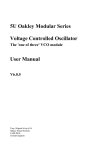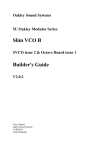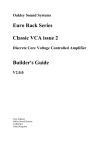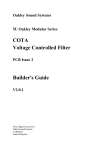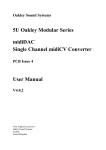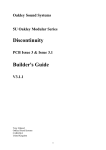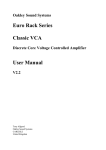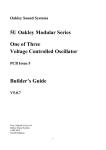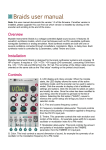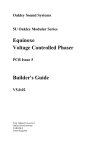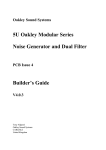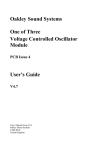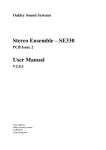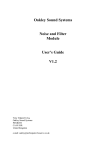Download Discontinuity User Manual
Transcript
Oakley Sound Systems 5U Oakley Modular Series Discontinuity PCB Issues 2, 3 & 3.1 User Manual V3.1.1 Tony Allgood Oakley Sound Systems CARLISLE United Kingdom 1 A render of the suggested front panel design in a 2U wide 5U high MOTM format. 2 Introduction This is the User Manual for the Discontinuity 5U module from Oakley Sound. This document contains an overview of the operation of the unit and the calibration procedure. For the Builder's Guides, which contain a basic introduction to the boards, a full parts list for the components needed to populate the board or boards, and a list of the various interconnections, please visit the main project webpage at: http://www.oakleysound.com/discon.htm For general information regarding where to get parts and suggested part numbers please see our useful Parts Guide at the project webpage or http://www.oakleysound.com/parts.pdf. For general information on how to build our modules, including circuit board population, mounting front panel components and making up board interconnects please see our generic Construction Guide at the project webpage or http://www.oakleysound.com/construct.pdf. The prototype issue 2 module behind a natural finish Scheaffer panel in the MOTM format. 3 The Oakley Discontinuity The Discontinuity is an updated version of an older Oakley module called the Wavefolder. Both devices are voltage controlled waveshaper modules designed primarily for use in modular analogue music synthesisers. The module comes in our standard 5U high 2U wide format which is directly compatible with Synthtech's MOTM series. The Discontinuity module, although using the same core technology as the old Oakley Wavefolder, is different enough in circuitry, usage and front panel design to be worthy of a new name. And it is the new discontinuity and offset controls and CV inputs that make this module very unique. Waveshaper modules work very differently to, and perhaps less intuitively than, other sound shaping modules such as filters, ring modulators and amplifiers. As such the Discontinuity will take some time to get used to. However, when used to process simple VCO waveforms it is capable of creating some very beautiful tones, all of which can be varied dynamically in musically interesting ways. Input waveform type, whether triangle, sawtooth or sine, can have profound tonal differences in the Discontinuity's output. And varying the input level can also have some amazing affects. Internally the module is arranged as five sections connected in series. 1. The Soft Clipper. This circuit gently restricts all input signals to around +/- 5.5 volts peak. It essentially mimics an overdriven valve or tube amplifier. The output of this circuit passes directly to the next stage which is... 2. The Clamper. This prevents the output from going above or below a preset limit. Unlike the soft clipper circuit the clamping is hard and abrupt. And unlike the soft clipper the limit is completely voltage controllable. We call it the Threshold and it can be controlled with a front panel pot or input CV. Any input can be altered dramatically with this function. As well as being passed on to the next stage of the module, the output of clamper is available at its own output. A three way toggle switch, called 'polarity' although not marked as such on the front panel, offers three modes of clamping: a) POS – the input signal is clamped when it exceeds the threshold voltage. ie. if the threshold voltage is 2V, then all parts of the input signal that go above 2V will be clamped. b) NEG – the input signal is clipped when it falls below the inverse of the threshold voltage. ie. if the threshold voltage is 2V, then all parts of the input signal below -2V will be clamped. c) BOTH – the switch is in its middle position. Both negative and positive clipping takes place. ie. if the threshold voltage is 2V, then all parts of the input signal above 2V are clamped, and all parts of the input signal below -2V are clamped. 4 In the old Wavefolder when the signal was clamped the output signal was simply held at the threshold voltage. In the Oakley Discontinuity the output level during clamping can now be varied dynamically. This can be done either as a function of the threshold voltage, via the module's Discontinuity control and its CV input, or as a fixed offset with the Offset control and its CV input. Furthermore, the offset can either be applied symmetrically or asymmetrically depending on the Track/Oppose switch. What this means is that we can actually remove any proportion of the original signal at that point where it exceeds the threshold voltages and replace it with another input. In other words we can splice one waveform in place of another. This has the potential to make some very new and wonderful timbres. The track/oppose switch controls whether the offset voltage is added to the output waveform in a symmetrical or asymmetrical way. The switch's position only affects the negative part of the input waveform. If in track then the offset voltage is applied equally to both the negative and positive parts of the input waveform. ie. a 1V offset CV, with Discon set to 0%, will make the part of the waveform that is replaced when the threshold is exceeded be both be 1V. In Oppose mode, you have a 1V section in the positive part and -1V in the negative part of the input waveform. 3. The Clipper. What the Clamper bites off, the clipper returns. The Clip output is the part of the original input signal that gets chopped off by the clamper circuit. So if you put a 5V peak triangle waveform into the Clamper, set the threshold to be 2.5V and set the mode switch to BOTH, the Clamp output will give you the neatly clipped almost square wave output, while the clipper will give you the tips of the pointed bits of the original triangle waveform. 4. The Folder. The Discontinuity's fourth section is based around a four quadrant multiplier. Here the Clip out and Clamp out are mixed together. However, the clip output may be added or subtracted from the clamped signal. A pot and an external CV sets the mix ratio and polarity. Again, consider the 5V triangle waveform with the polarity switch set to either POS or NEG. With the Fold pot set to 0, you get the plain Clamped signal at the main output. Turn the Fold pot clockwise and the clipped signal will return to create the original signal once more. But keep turning it, and the clipped signal is now bigger then the original. Now turn the pot the other way. The clipped signal gets subtracted from the clamped signal. You can get full wave rectification, thus your triangle becomes another triangle at twice the frequency. Multiplication. Turn it up further and more harmonics come in. 5. The Amp. The last stage is a simple x10 amplifier. The Discontinuity can clip accurately down to small levels if you want, so you need a good amplifier to bring it up to a decent level again. And don't forget the Discontinuity will work with any signal, audio and CV. You can mangle EG outputs, LFOs and, of course, your VCO. 5 Power supply requirements The design requires plus and minus 15V supplies. The power supply should be adequately regulated. The current consumption is about +60mA for the +15V rail and -55mA for the -15V rail. Power is routed onto the PCB by a four way 0.156” MTA156 type connector or the special five way Synthesizers.com MTA100 header. Power connections – MOTM and Oakley The PSU power socket is 0.156” MTA 4-way header. This system is compatible with MOTM. Power Pin number +15V Module GND Earth/PAN -15V 1 2 3 4 The earth/pan connection has been provided to allow the ground tags of the jack sockets to be connected to the powers supply ground without using the module’s 0V supply. Earth loops cannot occur through patch leads this way, although screening is maintained. Of course, this can only work if all your modules follow this principle. Power connections – Synthesizers.com The PWR power socket is to be fitted if you are using the module with a Synthesizers.com system. In this case the PSU header is not fitted. The PWR header is a six way 0.1” MTA, but with the pin that is in location 2 removed. In this way location 3 is actually pin 2 on my schematic, location 4 is actually pin 3 and so on. Power Location number Schematic Pin number +15V Missing Pin +5V Module GND -15V Not connected 1 2 3 4 5 6 1 2 3 4 5 +5V is not used on this module, so location 3 (pin 2) is not actually connected to anything on the PCB. If the PWR header is fitted then the small wire link LK should be fitted. This connects the panel ground with the module ground. 6 How to Use this Module As I have already mentioned waveshapers can be less intuitive than other synth modules. This is especially true of the Discontinuity since it has several shaping functions available. In the introduction I went through the various internal modules of the Discontinuity module, here I will try to explain what each front panel control does in more detail. The Polarity switch determines what part of the waveform is to be affected by the module. In the POS position the module affects the positive parts of the input signal. That is all the parts of the input signal that are above zero volts. Note that the module is completely DC coupled this means that it will process slowly moving or even static control voltages as well as audio signals. Figure 1 shows a triangular input waveform being clipped by the module. Figure 1- Polarity set to POS showing basic clipping with threshold set to around 2V with no folding. The slightly sloped flat part of the clipping is caused by the AC coupled input of the digital scope I have used to make this picture and not the module itself When the Polarity switch is put in the NEG position then the module will only affect the negative portions of the input waveform. With the switch set to BOTH, its middle position, both negative and positive parts of the waveform are affected. Figure 2 – Polarity switch set to BOTH. Note both negative and positive parts of the input triangle wave input have been clipped to produce a symmetrically clipped output waveform. 7 The Threshold pot is a manual control that sets the point when the input signal is to be affected by the module. In figures 1 and 2 it is Threshold that sets the point at which the clipping starts, ie. the point at which the input waveform starts to become deformed. The Threshold value can be changed from around -7V to +7V with 0V being at the mid point. The pot features a dead zone near the middle. This means that it is very easy to set the pot to exactly 0V just by putting somewhere near the middle. When the threshold voltage is set to say +2V, ie. slightly right of its centre point, the input signal will be affected when it exceeds +2V if the Polarity switch is in either POS or BOTH, and when it falls below -2V when the Polarity switch is in either NEG or BOTH. This part is important to understand – the threshold pot will control both the negative and positive threshold voltages simultaneously but its position shows the positive threshold voltage only. The negative threshold voltage is always the inverse of the positive threshold voltage. For example, if the positive threshold is 3V the negative will be -3V and so on. Note: Setting the Polarity switch to BOTH and moving the threshold pot to 0V doesn't make much sense since all signals above and below 0V will be clipped. ie. you'll get nothing. However, this null result should also happen with any value of Threshold below 0V since how can you have a signal that is both below -1V and above 1V? But Discontinuity does not obey the laws of mathematics due to a quirk in the circuit topology. The output in this 'illegal' state becomes a pulse wave whose height and width are determined by the Threshold pot. With a triangle wave input and threshold values of just slightly negative the output will be a low amplitude square wave. As you decrease the threshold value further the square wave will narrow producing pulse wave of increasing amplitude. This behaviour was not originally intended but it's quite a useful feature to have. The Thresh CV pot controls the depth of the Thresh CV input. CV stands for control voltage and this can come from any voltage source such as an LFO, VCO or ADSR. In this way the threshold parameter can be varied automatically as if you were turning the Threshold pot manually and proportionally to the input control voltage. With the Thresh CV pot at its maximum value the threshold voltage will be equal to the input CV voltage. Figure 3. Slight positive folding causing a soft clipping type of effect. Note the slightly rounded tips of the triangle wave caused by the actions of the input soft clipping circuit. 8 With the Fold pot set to its middle dead band position the output is clipped at the level determined by the Threshold pot and its input CV. The Fold pot however lets you control the amount of the input signal that is allowed to return. At positions right of centre the input signal is allowed to return with the same phase. This means that positive going parts of the waveform are returned still going positive. The gain can be controlled by the Fold pot, with zero in the middle, unity or 100% around two o'clock, and 200% at its maximum. Figure 3 shows this happening where we can see the top and bottom parts of the waveform having a different gain to the middle parts. Look how the slope of the triangle wave is less at the points compared to the bits crossing the middle horizontal 0V line. It should be noted that when the fold pot is set the unity position, at around two o'clock, then the Threshold and Discontinuity parts of the circuit are effectively switched off and the unit is in a type of bypass mode. The output signal is more or less the same as the input signal. With the Fold pot turned left of centre the phase of the returned input signal is switched. This means positively going parts of the waveform are now negatively going. This means the output waveform appears to fold back on itself. This can create frequency doubling effects as the waveform now can cross the horizontal 0V line more often. Figure 4 shows the folding action showing the tips of the input triangle wave being bent in opposite directions. Figure 4. Folding with the Fold pot set to around -25% which is slightly left of its central position. The Fold CV pot controls the depth of the Fold CV input signal. Like the Thresh CV, the Fold CV input allows remote control over the fold parameter. Later on we will see that we can use the Fold CV as the modulator input of a ring modulator. The Discontinuity pot is probably unique in the world of modular synthesisers. Wave folding modules of various sorts have been around for sometime. Indeed, our own Wavefolder successfully introduced the technique to many people. The discontinuity mode is something else though and comes in part from the actual way that the original Wavefolder did its wave folding. When an input signal rises above the positive threshold voltage and/or below the negative threshold voltage, the input signal is actually removed and the threshold voltages put in its place. Now as we have seen the input signal, or a multiple of it, may then be returned by the action of the Fold pot, but let us for the moment assume that the Fold pot is set centrally. 9 The Discontinuity pot controls that proportion of the threshold voltages that are replacing the input signal. It can be varied from zero, ie. the replacement voltage is zero volts, to around two, which is double that of the threshold voltage. The middle position of the Discontinuity pot is calibrated to give unity. This means that at the middle position the replacement voltages are exactly the same as the Threshold voltages, in other words, the traditional Oakley Wavefolder action. As with the Fold and Threshold pots there is a dead zone built into the pot's movement so it is easy to locate the unity position. Figure 5 shows applying Discontinuity on a triangle wave. You can see the clipped sections are no longer flat sections at the threshold voltage, but at lower voltages. In this case the Discontinuity parameter is set to around 40%, that is around 9 o'clock on the front panel. You should remember that the Discontinuity pot sets the multiple of the threshold voltage and not the actual voltage itself. This means varying the Threshold pot will also vary the level of the replacement voltages. When the Threshold voltage is set to 0V, ie. its middle position, then varying Discontinuity will have no effect on the output signal. This is because 0V times any number is still 0V. Figure 5. Discontinuity on both negative and positive parts of the input waveform. Discontinuity is set at around 40% of the threshold voltage. The action of discontinuities in the waveform generate lots of high harmonics. These can be seen in figure 5 as orange blurs on the leading edge of the discontinuity. These blurs are actually reactions to the high frequencies inside the digital scope I have used to take these pictures. They could have been easily removed with a little low pass filtering after the output of the Discontinuity module. It's probably worth adding at this point that connecting any filter post-waveshaping will give you an even greater range of sounds. As with the other two front panel waveshaping pots the Discontinuity parameter can also be varied with an external control voltage. The Discon CV pot controls the modulation depth of a connected CV. As we have seen the Discontinuity pot allows us to control the voltage that replaces the input signal at that point when the threshold voltages have been exceeded. However, the 10 Discontinuity parameter is inherently tied to the threshold voltage set by the Threshold pot and Thresh CV. The Discontinuity module also allows another control over the level of the replacement voltage. This we call the offset and it's controlled by the Offset pot, its CV input and a switch called Track/Oppose. The key difference between the Offset and the Discontinuity parameter is that the Offset value is added (or subtracted) to the Threshold voltage, while the Discontinuity parameter multiplies the Threshold voltage. The Offset function and Discontinuity parameters can be used either on their own or together. This means that the replacement voltage (or voltages) can be a mixture of both multiplied or added Threshold voltages. The Offset pot does one of two things. Firstly with no jack inserted into the Offset CV socket it acts as a fixed voltage source. In its central position it produces 0V and no offset is added to to the threshold voltages. At its furthest right it produces just under +4V, and at its furthest left it produces -4V or so. If you do not want any offset to be added you must ensure that the Offset pot is centralised. The sensitivity of the pot is configured to be at its minimum near the centre of its travel. This should make finding the zero point easier than a standard linear pot taper. The Track/Oppose switch controls how the offset voltage is added to the threshold voltage to give us the replacement voltages. In track mode, the offset voltage is added equally to the negative and positive threshold voltages. This means that a 2V threshold and a -1V offset voltage will produce a 1V replacement voltage for the positive part, and a -3V replacement voltage for the negative part. This is because 2 + (-1) = 1, and -1 + (-1) = -2. You can see this in figure 6. Figure 6. Track mode showing a negative offset voltage making both replacement voltages move downwards. In Oppose mode the two offset voltages move in opposite directions. This means that the offset voltage is added to the positive threshold voltage to create the positive replacement voltage, while the offset voltage is subtracted to the negative threshold voltage to create the negative replacement voltage. This creates an offset voltage that creates a symmetrical discontinuity to the input waveform. Taking the above example, a threshold voltage of 2V and an offset voltage of -1V will give a 1V positive replacement voltage and a -1V negative replacement voltage. Since 2 + (-1) = 1 and -2 - (-1) = -1. 11 You may have noticed that the positive replacement voltage is not affected by the Track/Oppose switch. Indeed, only the negative parts are affected by the offset switch's mode. Remember too that if your polarity switch is in the POS position you'll not notice anything either. The wide range of the offset pot allows you to create negative positive replacement voltages and positive negative replacement voltages. In other words this is another way, besides the Fold pot, when you can actually reverse the polarity of the input waveform when the threshold voltages are exceeded. The Offset CV input is a standard CV input. Once inserted a jack will remove the internal connection to the Offset pot's voltage source. The Offset pot will function now as a standard reversible attenuator to the CV input. This will produce maximum gain in the right hand position with a gain of around +80% and a maximum gain of -80% to the left. The + and – percentages indicate that the pot can also control the phase of the input signal with inversion of the input signals to the left and in phase signals to the right. Middle position is zero meaning that the effects of the CV input are turned off. When the Discontinuity pot is turned fully left then the threshold voltage has no effect on the replacement voltages. This means that the Offset pot or CV has complete control over the output waveform when the threshold voltages are exceeded. With the Track/Oppose switch in Track module it is therefore possible to splice one waveform into another. If you use an audio signal into the Offset CV input then this signal will replace the input signal when the input exceeds the threshold voltages. Using the threshold pot one can 'crossfade' the input waveform with the offset waveform. It is not like analogue crossfading so expect some very interesting results. The Volume pot is a simple output level control. It is configured to have a gain of 10 which allows you to clip signals down very small and then boost them up again to suit the usual +/5V signals that any connected modules are expecting. It should be noted that the maximum output of the Discontinuity module is around +/-12V. So if you try to boost too much you'll get clipping at +/-12V. It won't damage the module – but it might hurt your ears! 12 Calibration Procedure There are four calibration trimmers in this module; two 6mm and two multiturn types. They should be adjusted in the order given here. It is most useful to use a trimmer tool with the multiturn trimmers. Spectrol and others make trimmer adjusters for less than a pound. But remember don’t use the little adjuster as a normal screwdriver, you’ll break it. The power supply voltages will slightly affect the calibration settings, particularly the two offset adjustments. The effect is minor though and it is unlikely that any further calibration should be required if you use the module with another power supply unless it is has substantially different output voltages. However, I do recommend that you allow both the module and the power supply to warm up before making any adjustments to the trimmers. In all of these adjustments it is important to ensure that your knobs are aligned correctly. That is, when the pointer is pointing upward the pot is indeed at its central point. The position of the TRK/OPP switch has no effect on the setting up. 1. OFF2 This adjusts the offset of the VCA in the ring modulator and thus how much Fold CV breaks through into the audio output. Set the Threshold, Fold and Volume pots to their maximum settings. Set the Discontinuity and Offset pots to their middle positions. Set the Polarity switch to its mid-point. All other pots should be set to their minimum positions. Adjust OFF2 until the front panel LED is completely extinguished. On either side of the optimum position the LED will glow either red or green. 2. ZERO This adjusts the central point of the Fold pot. Put the Discontinuity into ring modulator mode – ie. Threshold and Discontinuity pots set to minimum, Fold and Offset pots to their middle position. The Volume pot should be at its maximum setting. All other pots should be at their minimums. Connect a triangle wave source to the main input of the module and listen again to main output. Adjust ZERO until the sound you hear is minimised. Check that rotating the Fold pot just a little beyond its mid point, on either side, brings back the sound. 3. OFF1 This one needs a voltmeter; a decent digital one is best and it should be able to measure down to within 10mV. You will be measuring the voltage with respect to ground. This means that the negative probe needs to be connected to ground or 0V. The easiest point to access ground is the top pad of LK near the bottom of the board. Set the Offset, Fold and Threshold pots to their mid points. Set Discontinuity to full. Set all other pots to their minimum. Measure the voltage at pin 7 of U13 – this is down the bottom of the board near the UNITY trimmer. Adjust OFF1 until the voltage gets as close to zero volts as you can get it. It's a bit fiddly but anything between +/-10mV (+/-0.01V) is fine. 13 4. UNITY This is the difficult one to set up, but it's not going to blow up if you don't get it right so don't worry about it too much. If you have an oscilloscope then this will help, but if not, you can set it up by ear. After all, this is part of a musical instrument. The object of UNITY is to set the mid point of the Discontinuity pot. Set this right and when Discontinuity is set to its middle position the output waveform will not have any discontinuities and be simply clipped or folded. Set Fold, Offset, Discontinuity and Volume to their middle positions. Set the polarity switch to its middle position. All other pots can be set to their minimum positions. Connect a sine wave to the input of the module and listen to the output. Alter the Threshold until the sound you hear resembles a square wave – a hollower sound, as opposed to the smooth sine wave tone. This will be when the Threshold pot is set to around two o'clock. Now adjust the UNITY trimmer until you find a point that seems more hollow than reedy. You'll find either side of this point will be more buzzy and harsh. If you have a scope you'll see your waveform has a neat flattened top. Moving UNITY beyond its optimum point will give the waveform sharp pointy edges and the flattened part will either be below or above the threshold point. 14 Final Comments I hope you enjoy using the Oakley Discontinuity. If you have any problems with the module, an excellent source of support is the Oakley Sound Forum at Muffwiggler.com. Paul Darlow and I are on this group, as well as many other users and builders of Oakley modules. If you have a comment about this user manual, or have a found a mistake in it, then please do let me know. Last but not least, can I say a big thank you to all of you who helped and inspired me. Thanks especially to all those nice people on the Synth-diy and Analogue Heaven mailing lists and those at the Muffwiggler.com forum. Tony Allgood at Oakley Sound Cumbria, UK © June 2012 – updated September 2013 No part of this document may be copied by whatever means without my permission. 15















